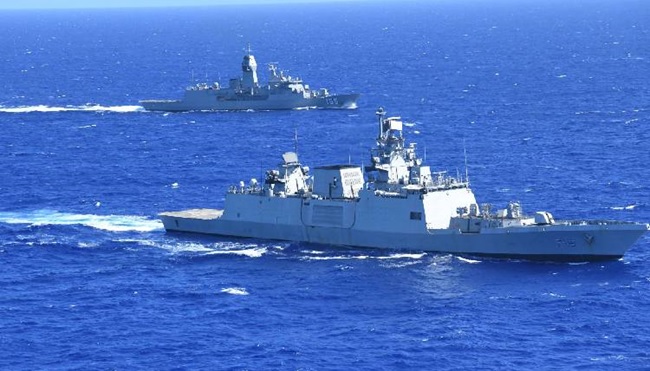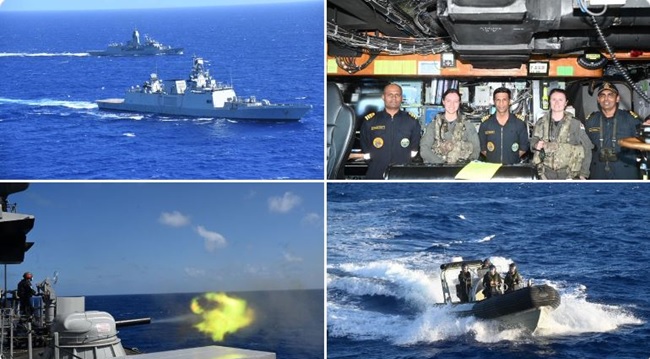Prelims: (Defence Exercises, International Relations + CA)
Mains: (GS 2 - International Relations, GS-3: Security) |
Why in News?
The Indian Naval Ship INS Sahyadri recently participated in AUSINDEX 2025, held in the Northern Pacific region. The exercise forms a key component of India–Australia defence cooperation and aims to boost interoperability between the two navies.

About Exercise AUSINDEX
Overview
- AUSINDEX is a bilateral maritime exercise conducted between the Indian Navy and the Royal Australian Navy.
- It is a biennial (every two years) exercise, first held in 2015.
- It focuses on strengthening the India–Australia strategic and security partnership in the Indo-Pacific.
Aim
- To enhance interoperability,
- Deepen maritime domain cooperation,
- Improve coordination in air, surface, and subsurface operations.
Key Highlights of AUSINDEX 2025
- Warships and aircraft from both navies conducted complex joint operations, including:
- Anti-submarine warfare drills
- Gunnery exercises
- Advanced flying operations
- Surface tracking and manoeuvre exercises
- The participating platforms included:
- INS Sahyadri (Indian Navy)
- HMAS Ballarat (Royal Australian Navy)
These drills strengthen operational synergy for real-world contingencies in the Indo-Pacific.

Significance of AUSINDEX
Enhances India–Australia Strategic Ties
- Reinforces cooperation under the Comprehensive Strategic Partnership (CSP).
- Supports both nations’ commitment to a free, open, and rules-based Indo-Pacific.
Strengthens Maritime Security
- Enhances preparedness against maritime challenges such as:
- Submarine threats
- Illegal fishing
- Maritime terrorism
- Freedom of navigation issues
Improves Warfighting Readiness
- Interoperability in multi-domain operations improves:
- Tactical coordination
- Information sharing
- Maritime domain awareness
Supports Broader Multilateral Frameworks
- Complements other platforms like:
- Quad
- Malabar Exercise
- Indian Ocean Region (IOR) collaborations
Challenges
Operational and Logistical Complexities
- Conducting exercises in remote regions like the Northern Pacific requires:
- Long-range deployments
- Multi-layer coordination
- High resource allocation
Security Dynamics in the Indo-Pacific
- Increasing geostrategic competition, especially involving:
- China
- US alliance systems
- AUKUS developments
creates a complex security backdrop.
Technology Interoperability Limitations
- Differences in naval platforms, data systems, and communication protocols still require harmonisation.
Way Forward
Enhance Frequency & Scope of Exercises
- Expand AUSINDEX to include more advanced operations such as:
- Underwater autonomous systems
- Joint ISR operations
- Carrier/air combat integration
Strengthen Indo-Pacific Coalition Building
- Deepen synergy with Quad partners for secure maritime commons.
Boost Defence Industrial Collaboration
- Promote co-development in:
- Maritime surveillance systems
- ASW technologies
- Naval drones
Expand Maritime Domain Awareness (MDA) Sharing
- Real-time intelligence exchange can improve regional maritime security.
Other Defence Exercises Between India & Australia
|
Exercise
|
Domain
|
Nature
|
|
AUSTRA HIND
|
Army
|
Bilateral
|
|
Pitch Black
|
Air Force
|
Multilateral (hosted by Australia)
|
|
Malabar
|
Navy
|
Multilateral (India, Australia, US, Japan)
|
|
Quad Naval Cooperation
|
Navy
|
Multilateral
|
FAQs
1. What is AUSINDEX?
A bilateral naval exercise between India and Australia, conducted biennially since 2015.
2. What is the purpose of AUSINDEX 2025?
To enhance interoperability and strengthen maritime cooperation through anti-submarine warfare, gunnery, and flying operations.
3. Which ships participated in AUSINDEX 2025?
INS Sahyadri (India) and HMAS Ballarat (Australia).
4. Why is India–Australia naval cooperation significant?
Both countries are key partners in maintaining stability, security, and freedom of navigation in the Indo-Pacific region.
5. What other exercises do India and Australia conduct together?
AUSTRA HIND, Pitch Black, Malabar, and Quad naval engagements.
|





